Key takeaways:
- Cinematography techniques, including camera angles and color grading, significantly enhance emotional engagement and narrative depth in films.
- Lighting and composition are crucial for establishing a film’s tone, evoking feelings that dialogue alone may not convey.
- Analyzing films through tools like shot lists and discussions at film festivals can deepen understanding of cinematographic techniques.
- Sharing analysis and engaging with others can transform perspectives, revealing new insights into film interpretations.
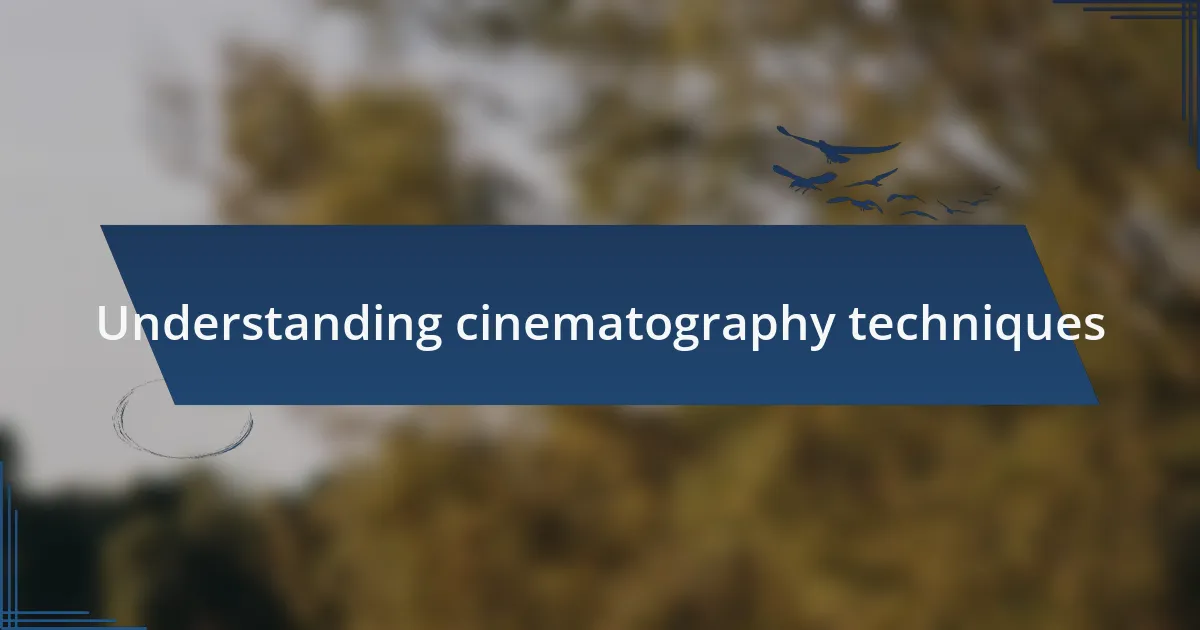
Understanding cinematography techniques
Cinematography techniques are like the brushstrokes of a painter; they transform a mere script into a visual masterpiece. I remember watching “Blade Runner” for the first time and being completely captivated by the use of light and shadow. Those choices didn’t just tell a story; they evoked emotions that lingered long after the credits rolled. Have you ever felt drawn into a film simply because of how it looked? That’s the power of cinematography.
When analyzing cinematography, I often focus on how camera angles and movements enhance narrative and emotional impact. For instance, a low-angle shot can make a character appear powerful or intimidating, while a high-angle shot can evoke vulnerability. I once saw this in a small indie film where a central character was shown from above during a moment of defeat—an effective choice that made the audience feel their despair. This kind of intentional shot composition reveals a deeper layer of storytelling that enriches the viewing experience.
Moreover, color grading plays a significant role in shaping a film’s atmosphere. I recall watching “Moonlight,” where the rich tones and vibrant hues mirrored the journey of self-discovery and conflict. It left me wondering: how do these visual choices influence your own emotional responses while watching films? Each decision in cinematography invites us to engage with the narrative in a more profound way, creating a dialogue between the viewer and the visual experience.
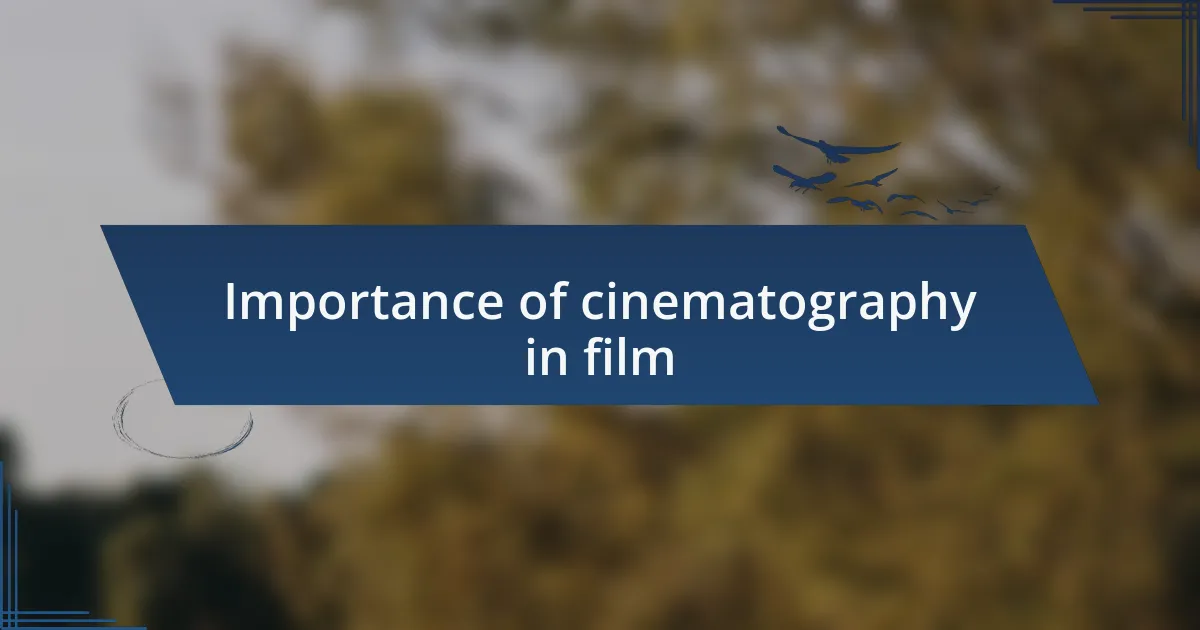
Importance of cinematography in film
Cinematography is crucial in establishing a film’s tone and mood. I vividly remember watching “In the Mood for Love,” where the lush, soft focus created an intimate yet melancholic atmosphere. This visual approach made me ponder how much the right shot can evoke a sense of longing and nostalgia, even without words. Isn’t it fascinating how visuals can convey feelings that dialogue sometimes can’t?
The use of light and shadow is another fundamental aspect that underscores a film’s emotional landscape. During a recent screening of “The Revenant,” I was struck by how the stark contrasts in lighting not only intensified the harshness of the wilderness but also mirrored the protagonist’s internal struggle. It made me think: how do filmmakers choose the perfect lighting to reflect the characters’ journeys? These decisions become integral to our understanding of the story, turning moments of silence into powerful visual statements.
I often find myself reflecting on how cinematography can shape our perception of characters. Watching “Call Me by Your Name,” I was captivated by the sun-drenched landscapes and the careful framing that highlighted the characters’ connections. Each shot felt like a brush with intimacy, raising questions about how beautifully crafted visuals can deepen our empathy for the characters. Don’t you think that when cinematography is executed well, it elevates a film from just entertainment to an unforgettable experience that resonates on multiple levels?
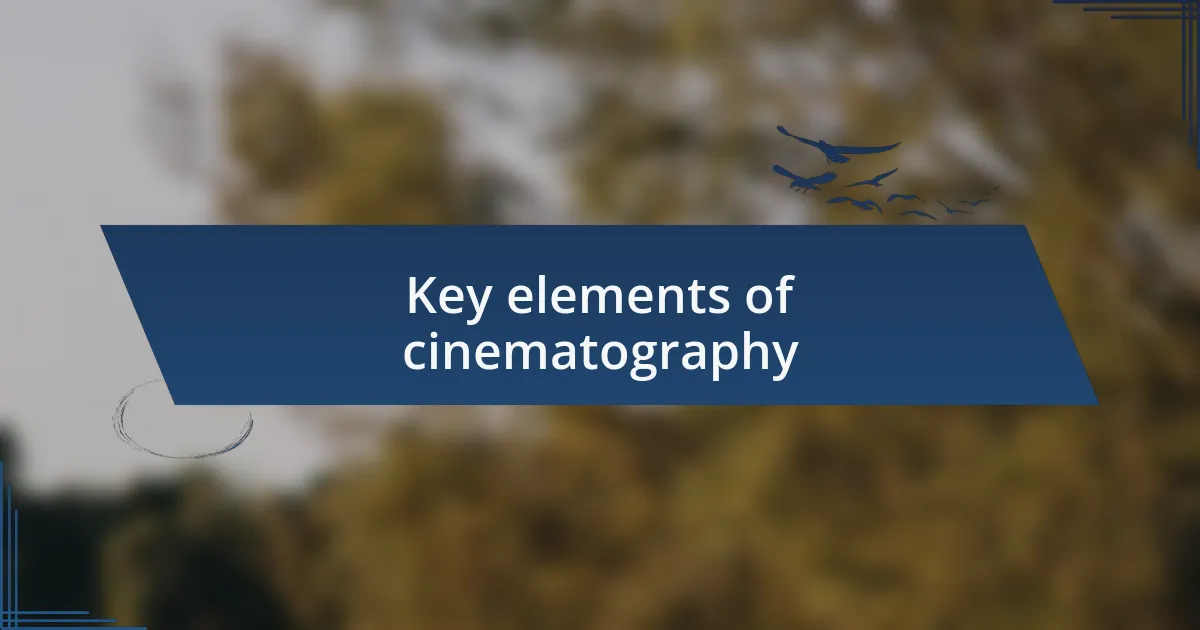
Key elements of cinematography
When analyzing key elements of cinematography, one cannot overlook composition. The arrangement of elements within a frame can profoundly influence how a scene is perceived. I recall watching “Blade Runner 2049” and being mesmerized by how the symmetrical framing and meticulous placement of objects sparked a sense of balance and unease simultaneously. Can you imagine how differently the scene would’ve felt had the composition been chaotic?
Another critical element is camera movement, which lends dynamism to the storytelling. I often think about “Birdman,” where the continuous camera movement created an immersive, almost surreal experience. The flowing transitions made me feel as if I were part of the characters’ chaotic world, raising the question: how does this fluidity affect our emotional connection to the narrative?
Lastly, color grading plays a pivotal role in establishing the film’s emotional core. Consider “Mad Max: Fury Road,” where vibrant colors juxtaposed against the harsh landscape conveyed desperation alongside hope. I couldn’t help but marvel at how those bold choices affected my perception of the characters’ struggles. Isn’t it revelatory how subtle shifts in color can alter our emotional engagement with the storyline?
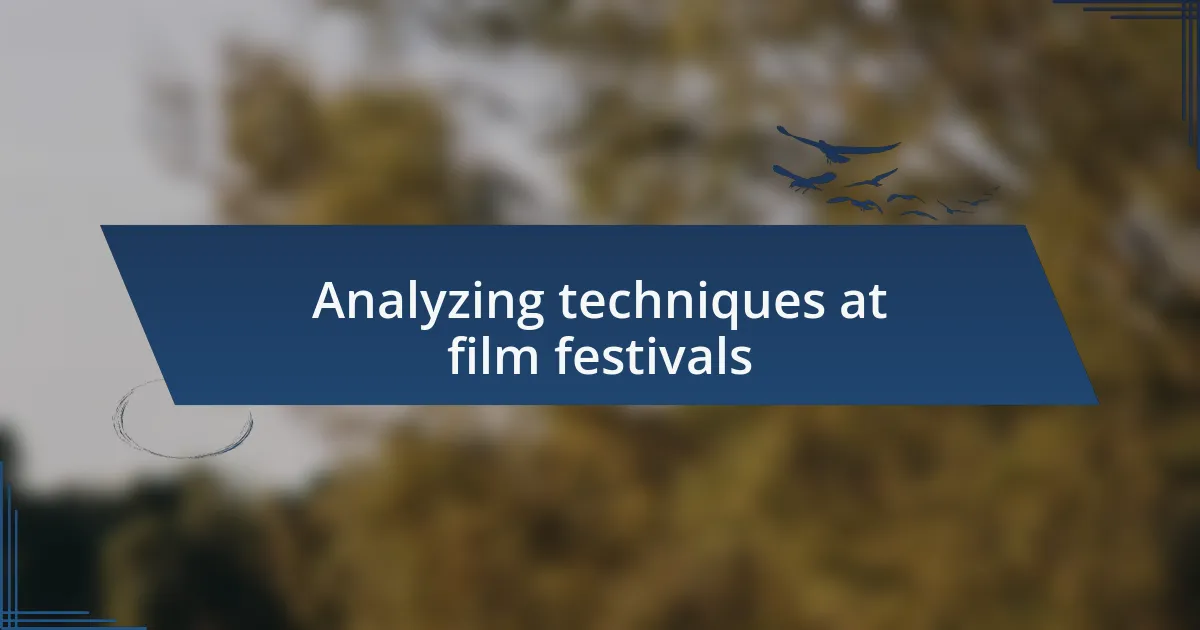
Analyzing techniques at film festivals
Analyzing techniques at film festivals reveals a treasure trove of creative approaches. I remember attending a screening at Sundance where the use of lighting in an indie film caught my eye. The director employed stark contrasts between light and shadow, which enhanced the emotional weight of pivotal scenes. Have you ever experienced a moment when a simple light change transformed your understanding of a character’s inner turmoil?
In evaluating sound design at festivals, it’s fascinating to see how it complements visual storytelling. I once watched a documentary where the absence of sound during a climactic scene was deafening. It struck me how this choice intensified the tension—silence can be as powerful as a roaring score. Isn’t it intriguing how a film can evoke such visceral reactions with minimalistic techniques?
Moreover, the innovative use of framing and angles provides rich layers to filmmakers’ narratives. During a screening at Cannes, a filmmaker creatively employed extreme close-ups that drew me into the protagonists’ emotional landscapes, forcing me to confront their vulnerabilities. Have you ever felt a rush of empathy simply because of how the camera captured a fleeting expression? The way we perceive characters can shift entirely based on these nuanced cinematographic decisions.
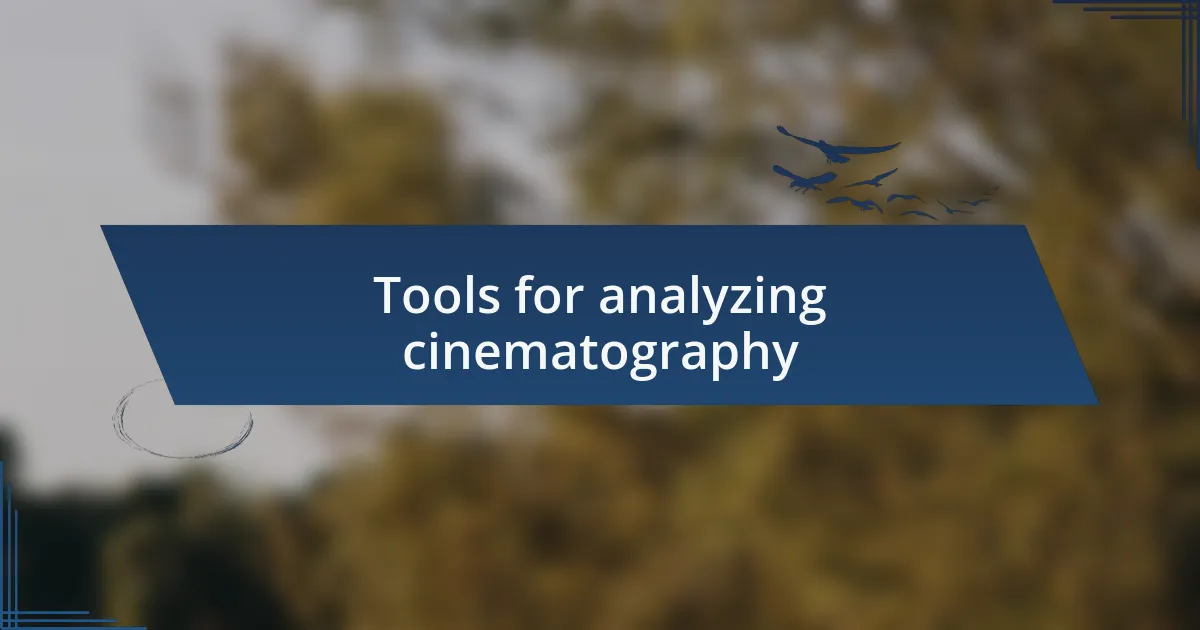
Tools for analyzing cinematography
When it comes to analyzing cinematography, tools like shot lists and detailed scene breakdowns can be crucial. I often find myself creating shot lists when watching films to track the specific framing and camera movements used in pivotal moments. This not only helps me appreciate the techniques but also enhances my understanding of how these choices influence audience perception. Have you ever jotted down notes during a film that made you reevaluate a shot’s impact?
Another effective tool is software specifically designed for film analysis. I’ve enjoyed using programs that allow me to tag specific moments in a film, linking them to notes about the use of color, lighting, and composition. By revisiting these tagged moments, I can dig deeper into how visual elements contribute to the storytelling. Have you ever analyzed a film in a way that reshaped your understanding of its narrative?
Lastly, engaging discussions and workshops at film festivals prove to be invaluable. I recall participating in a panel where experts dissected a renowned director’s unique styles. Listening to their insights not only sparked my curiosity but also gave me new vocabulary and frameworks to articulate my thoughts on cinematography. Have you ever left a conversation about film feeling inspired to explore an aspect you’d never considered before?
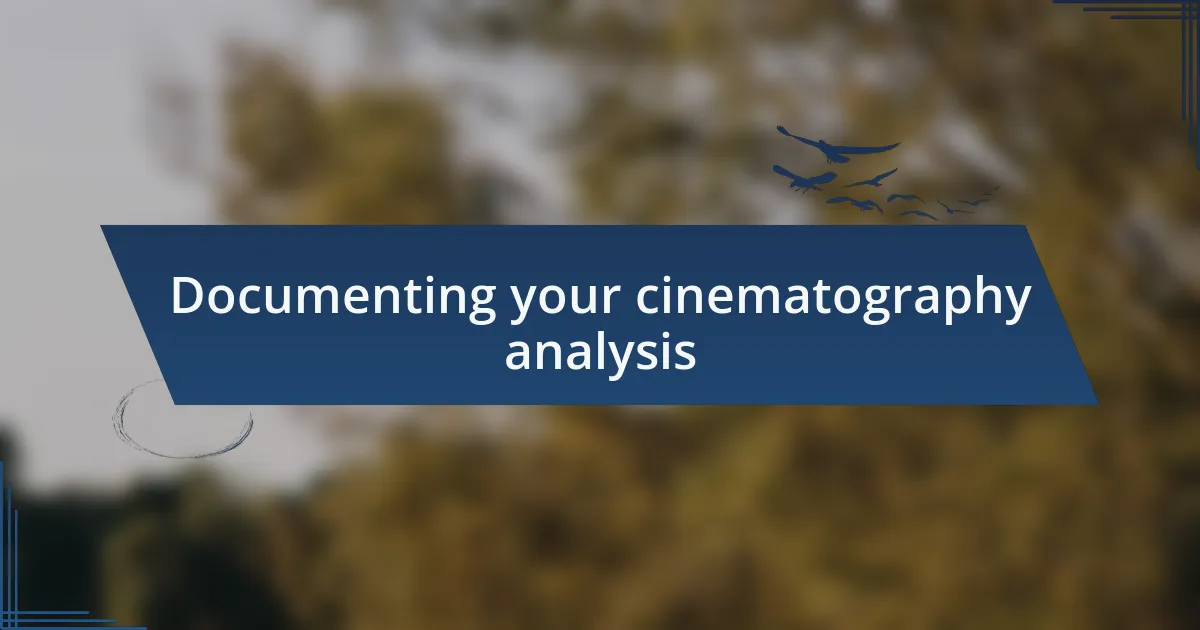
Documenting your cinematography analysis
Documenting your analysis of cinematography can be immensely rewarding. I often find that keeping a dedicated journal enhances my understanding of film techniques. After studying a film, I jot down my thoughts on the specific shots that struck me, capturing the emotions they evoked. How often do we overlook these details in the rush of our daily lives?
When reviewing my notes, I focus on recurring themes in my observations. For example, I once analyzed a film where the use of shadows seemed to communicate the protagonist’s internal struggle. I sketched out key scenes and annotated them with feelings and interpretations, which helped me appreciate how these choices shape narrative and viewer engagement. Has reflecting on your own notes ever led you to discover a new layer of meaning in a film?
The act of sharing my insights with fellow film enthusiasts has been a transformative experience. Engaging in discussions about my documented observations has opened up new dimensions in my analysis. I remember a conversation where I shared my notes on a particular color palette, only to hear others’ perspectives that challenged my own view. This back-and-forth not only enriched my understanding but also fostered a deeper connection to the film. How has sharing your thoughts with others influenced your perception of cinematography?
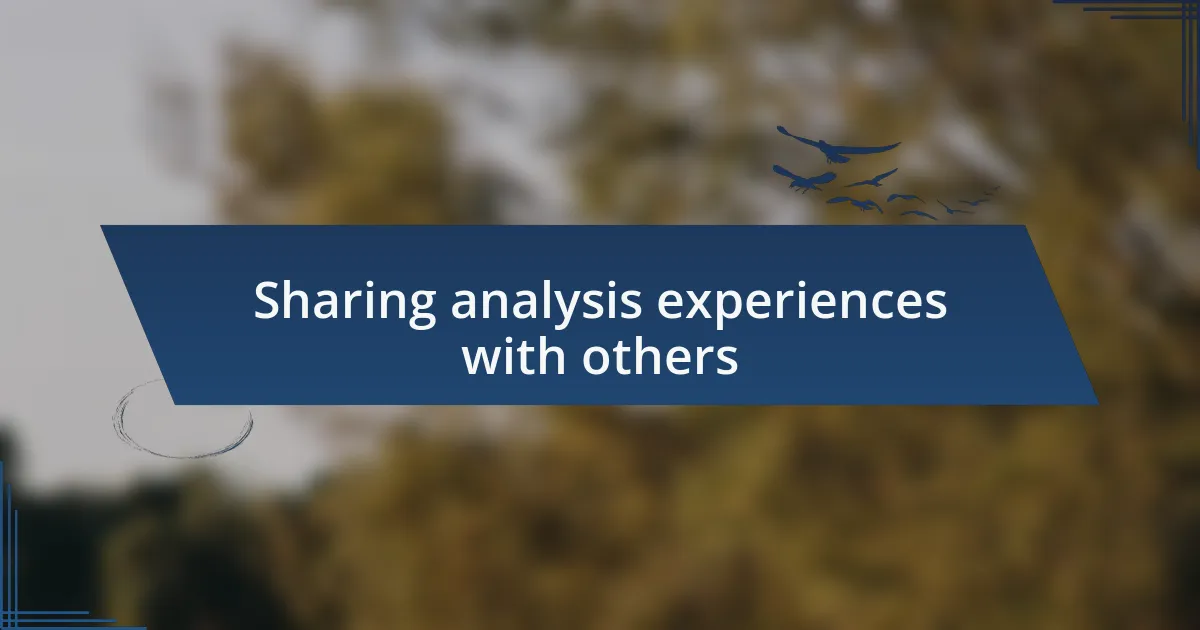
Sharing analysis experiences with others
Engaging with others about my cinematography observations has often sparked enlightening conversations. For instance, during a small film club meeting, I shared my thoughts on camera angles in a classic noir film. One member expressed how those same angles evoked a sense of entrapment, which made me reconsider my interpretations. Have you ever had a moment like that where someone else’s insight shifted your perspective?
I find that sharing my analyses can truly deepen my appreciation for cinematic techniques. While discussing a recent film with a friend, I mentioned how the lighting set the emotional tone in pivotal scenes. She brought up the significance of sound design in those moments, leading us to realize that every element is interconnected. How has someone else’s viewpoint challenged or enhanced your understanding of a film?
The excitement of collaborative analysis is palpable, and I cherish those moments of discovery. Recently, I participated in an online forum where I shared my analysis of a film’s use of framing. The varied interpretations I received opened my eyes to aspects I hadn’t considered, such as cultural context and historical relevance. Isn’t it fascinating how sharing our viewpoints can unveil new dimensions in film?